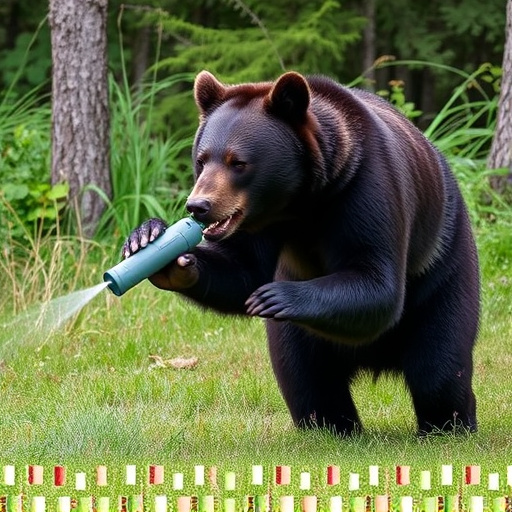Bear spray, a key safety tool for Alaska's wild areas, is most effective at 20-30 feet (6-9 meters) range. Aiming for the bear's face and eyes, with precise spraying techniques, creates a disorienting barrier to repel bears. Understanding this optimal distance and correct usage enhances safety while navigating bear country, especially in challenging terrain like forests where staying calm and securing protection behind obstacles is vital.
Alaska’s rugged wilderness presents unique challenges, especially when encountering bears. This guide explores the essential tool for self-defense: bear spray. From understanding its chemical composition to mastering application techniques, we delve into the science behind its range and effectiveness. Learn how to choose the right safety clip for optimal protection and navigate real-world scenarios where bear spray offers crucial benefits in Alaska’s diverse ecosystems, all while ensuring safe distances for maximum efficacy.
- Understanding Bear Spray: A Vital Tool for Alaska's Wildlands
- The Science Behind Bear Spray Range and Effectiveness
- Choosing the Right Bear Spray Safety Clip for Optimal Protection
- Effective Use of Bear Spray: Techniques and Best Practices
- Real-World Scenarios: When and Where Bear Spray is Most Beneficial in Alaska
Understanding Bear Spray: A Vital Tool for Alaska's Wildlands
Bear spray, also known as bear repellent, is a crucial tool for anyone venturing into Alaska’s wildlands. It’s designed to create a barrier between you and potentially dangerous bears, offering vital seconds to escape or deter an attack. Understanding how and when to use it effectively can significantly enhance your safety in bear country.
The best distance for bear spray effectiveness is generally considered to be around 20-30 feet (6-9 meters). At this range, the spray can create a foggy cloud that blocks the bear’s senses, temporarily disorienting and repelling it. It’s important to remember that wind conditions can affect the spray’s reach, so always aim slightly upstream or into the wind for optimal results. Proper usage involves spraying directly towards the bear’s face and eyes, creating a dense barrier that slows its movement and gives you time to retreat safely.
The Science Behind Bear Spray Range and Effectiveness
Bear spray, also known as bear repellent, is a crucial tool for anyone venturing into bear country. The science behind its effectiveness revolves around creating a barrier between you and the bear by spraying capsaicin, the active ingredient, into the bear’s eyes and respiratory system. This irritates and disorientates the bear, allowing you to escape or defend yourself if needed.
The best distance for bear spray effectiveness is generally considered to be within 20-30 feet (6-9 meters). At this range, the spray can cover a wide area, including the bear’s face and body, ensuring maximum impact. Beyond this distance, the spray may not reach the bear effectively, reducing its ability to deter an attack. Understanding the optimal range ensures users get the most out of their bear spray during encounters in Alaska’s wild landscapes.
Choosing the Right Bear Spray Safety Clip for Optimal Protection
When selecting a bear spray safety clip, understanding the ideal distance for maximum effectiveness is key to ensuring your protection in the event of an encounter. The best distance for bear spray to be effective typically ranges from 20 to 30 feet (6 to 9 meters). This range allows for sufficient coverage area while still providing enough control time.
Choosing a clip designed for optimal reach and ease of use is essential. Look for features like adjustable nozzle settings, which can help fine-tune the spray pattern to match your surroundings. A durable yet lightweight clip that securely attaches to your person or gear will ensure you have quick access during an unexpected encounter, increasing your chances of safety and escape.
Effective Use of Bear Spray: Techniques and Best Practices
When used correctly, bear spray can be an effective deterrent against aggressive bears. The key to its success lies in understanding and adhering to best practices for application. One crucial aspect is maintaining the recommended distance, typically around 20-30 feet (6-9 meters), from the bear when deploying the spray. This distance ensures that the spray reaches the bear’s eyes and nose, two vital areas for irritation and disorientation.
To maximize effectiveness, individuals should aim directly at the bear’s face, ensuring full coverage. It is important not to spray in a wide pattern or in the direction of other bystanders, as this can reduce the concentration on the target bear and potentially cause harm to others nearby. Rapid deployment is also essential; pulling the trigger for 3-5 seconds will usually release enough spray to deter an attacking bear, giving you time to retreat safely.
Real-World Scenarios: When and Where Bear Spray is Most Beneficial in Alaska
In real-world scenarios, bear spray is most beneficial in Alaska when hikers, campers, and outdoor enthusiasts encounter grizzly bears or black bears in their natural habitats. The best distance for bear spray effectiveness typically ranges from 20 to 30 feet (approximately 6 to 9 meters), though the range can vary based on factors like wind, spray pattern, and the size of the bear. In dense forests where visibility is low, it’s crucial to stay calm, ensure your back is against a tree or rock for protection, and use bear spray from this safe distance to deter an approaching bear. Moreover, knowing how to properly operate the spray can significantly enhance its effectiveness during encounters in remote Alaskan landscapes, where immediate evacuation might not be feasible.
In the unpredictable wilderness of Alaska, bear spray safety clips are an indispensable tool for outdoor enthusiasts. By understanding the science behind its range and effectiveness, choosing the right equipment, and mastering proper usage techniques, individuals can effectively protect themselves in potential bear encounters. The best distance for bear spray effectiveness is around 20-30 feet, but awareness and preparedness are key, regardless of range. Embracing these practices ensures a safer experience while exploring Alaska’s beautiful yet wild landscapes.
